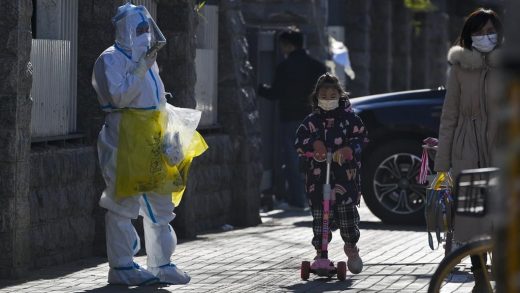U.S.-Canada world championship final is no guarantee as competitive gap in women’s hockey gap closes

Fond as Hilary Knight is of the fierce women’s hockey rivalry between the United States and Canada, the 34-year-old has watched her sport’s international growth enough to realize the decades-long era of North American dominance might finally be coming to close.
Whether that happens at this year’s 10-nation world championship, which opens in Utica, New York, on Wednesday, or at the 2026 Winter Olympics, the U.S. captain said she can envision a time when the Americans and Canadians aren’t a lock to meet with a gold medal on the line.
“It just speaks to there’s more eyes on the sport, there’s more investment. More countries are able to show up and play, and I think it’s awesome,” said Knight, a nine-time world champion who is preparing to compete in her 14th tournament. “And that’s why you really have to take this tournament one game at a time because nothing’s guaranteed.”
There’s a similar expectation — don’t call it a concern — growing in Canada, where two-time Olympic defenseman Renata Fast welcomes the challenge of nations bridging the competitive gap.
“As a high-performance athlete, you want to play the best, you want other teams to make it tough,” Fast said. “All of our goals is to grow the game. And the more challenges, the better.”
Make no mistake, the defending champion Americans and Canadians are favored to play for gold on April 14 for what would be the 22nd time in 23 tournaments. The only exception came in 2019, when host team Finland upset Canada in the semifinals before losing a shootout to the Americans.
While Finland remains a contender, fast-rising Czechia — winners of the past two bronze medals — and a young Swedish team are showing signs of being ready to mount a challenge.
“We’re not resting on our laurels by any means,” Czech coach and former Canadian Olympian Carla MacLeod said of her team that as recently as 2015 was playing in the IIHF’s second division.
“The mission is clear. Everyone is doing their darndest to try to give their teams the best opportunity to win a gold medal, and we’re no different,” she added. “Is the time now, is the time later? We’ll never know. … But I think that gap is going to close.”
The Swedes, who haven’t medaled since 2007, are brimming with confidence.
They’re buoyed by a roster that might be young — 14 players are 22 or younger — but features nine who have won silver on under-18 teams in 2018 and 2023. And Sweden returns a majority of a team that nearly toppled Canada in a 3-2 overtime loss in the world quarterfinals last year.
“We don’t respect them like maybe we did a few years ago,” 18-year-old Mira Jungaker said, referring to the U.S. and Canada. “Like, we still respect them, of course, but not on the ice (and we are) going on the confidence that we can actually beat them.”
The competitive landscape of women’s hockey is shifting with more European nations having their players develop at U.S. colleges. This year’s launch of the six-team Professional Women’s Hockey League is expected to spur the level of parity further by attracting more international players to North America.
Though a majority of PWHL players are currently Canadians and Americans, the league is eager to expand its reach. Five Czechs are competing in the PWHL, and MacLeod called it notable how much their confidence has grown in showing they can play with the best.
“They’re learning that they’re not just players in the league, they’re impact players in the league,” said MacLeod, who doubles as coach of PWHL Ottawa, which features two Czechs, including Katerina Mrazova, who is tied for third in the scoring race with 17 points (six goals, 11 assists).
Czech defenseman Aneta Tejralova, who also plays for Ottawa, is taking over as captain following the retirement of Alena Mills, while the team will be without PWHL Montreal’s Dominika Laskova, who is sidelined by an injury.
The Czechs welcome back goalie Klara Peslarova, who missed last year’s world championship due to an injury. Peslarova went 2-3 while allowing just seven goals en route to a seventh-place finish in their Olympic debut at the 2022 Beijing Games.
The Americans are going younger, with third-year coach John Wroblewski interested in developing depth, while replacing the losses of forward Amanda Kessel to retirement and top defenseman Lee Stecklein, who is focusing this year on playing for PWHL Minnesota.
Forwards Kirsten Simms, who at 19 led college hockey in scoring last season, Laila Edwards, 20, and Joy Dunne, 18, and defenseman Sydney Morrow, 19, are making their national team world debuts.
“The thought process is we can wait for them to be ready or that they’re going to get there and we just work to expedite the process,” Wroblewski said.
The Americans welcome back Kendall Coyne-Schofield, who sat out 2023 to give birth to her son Drew.
Canada returns much of the experienced core of the Marie-Philip Poulin led-team that won gold at the 2022 Winter Games. And it’s a group that coach Troy Ryan expects to stay together through the 2026 Games.
“You beat them with experience and the ability to know how to win,” Ryan said of a team that also won world championships in 2021 and ’22 before settling for silver in a 6-3 loss to the Americans last year.
“I don’t think we have to redo anything. I think we’re in a good spot,” Ryan said. “It’s not like our group is just, you know, washed up by any stretch of the imagination.”
___
AP Women’s Hockey: https://apnews.com/hub/womens-hockey
Credit: U.S.-Canada world championship final is no guarantee as competitive gap in women’s hockey gap closes


